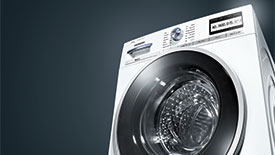Remove the dispenser from the washing machine according to the instructions in the Use & Care Guide. Place the dispenser under warm, running water and lightly wipe away any remaining detergent residue. Reinsert the dispenser according to the instructions in the Use & Care Guide.
First aid
Problem Category
Select Problem
Select Problem
Solution
After your washing machine has washed a load, allow the interior of the machine to air out by leaving the door partially open. This will allow air to circulate and help dry out any remaining moisture in the drum or on the gasket. Wipe the gasket with a soft cloth to remove residual water or any detergent. The existence of any residual detergent can be a sign that too much detergent is being used.
Solution
Use a mild, non-abrasive, chlorine-free cleaning agent. Rinse and then dry with a soft cloth. Do not use steel wool or any other abrasive cleaning agents.
Solution
Use hot, soapy water or a mild, non-abrasive cleaning agent with a soft cloth. Rinse and then dry with a soft cloth.
Solution
This is necessary if very little or no water flows into the washing machine. In hard water areas, cleaning is recommended every 6 months to reduce valve blockages. Follow these directions:<br/>1. Disconnect the hose from the water faucet.<br/>2. Rinse the filter under running water.<br/>3. Reconnect the hose and filter.<br/>4. Carry out the above for both hot and cold water faucets.
Solution
Our tested and approved descaler gives great results if used every 3-6 months to ensure limescale is fully removed. The frequency depends on the usage of the appliance and the hardness of the local water. The descaler is essential in hard water areas. Washing machines should undergo a regular 90°C maintenance wash to avoid limescale and odours.
Solution
1. Empty the contents of the box (without laundry) into the washing machine drum. 2. Run the 60°C coloured laundry programme without pre-wash. 3. Run the programme again for thorough cleaning.


